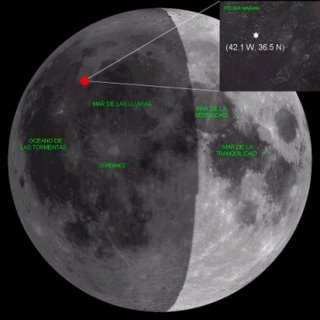Lunar Impact
Probably, the cause was a 12cm meteorite that slammed on the lunar surface at a speed of about 97.200 km/h. The impact may have opened a small crater of about 3 meters of width and 0,4 meters of depth. It was so small that even the Hubble space telescope could not see it.

Credits of the image: NASA/MSFC/Bill Cooke
The image of this shock, which reached 7 of visual magnitude, was captured with a video camera connected to a 25cm telescope of opening, by Rob Suggs and his colleague Wes Swift of the Marchall Space Flight Center - MSFC.

Sequence of 6 frames of the video, in false color. Credits of the image: Wes Swift/NASA.


































